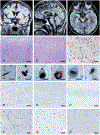TARDBP variation associated with frontotemporal dementia, supranuclear gaze palsy, and chorea
- PMID: 19609911
- PMCID: PMC12399026
- DOI: 10.1002/mds.22697
TARDBP variation associated with frontotemporal dementia, supranuclear gaze palsy, and chorea
Abstract
TDP-43 has been identified as the pathological protein in the majority of cases of frontotemporal lobar degeneration and amyotrophic lateral sclerosis (ALS). TARDBP mutations have so far been uniquely associated with familial and sporadic ALS. We describe clinicopathological and genetic findings in a carrier of the novel K263E TARDBP variation, who developed frontotemporal dementia, supranuclear palsy, and chorea, but no signs of motor neuron disease. Neuropathologic examination revealed neuronal and glial TDP-43-immunoreactive deposits, predominantly in subcortical nuclei and brainstem. This is the first report of a TARDBP variation associated with a neurodegenerative syndrome other than ALS.
Conflict of interest statement
Potential conflict of interest: None reported.
Figures

References
-
- Arai T, Hasegawa M, Akiyama H, et al. TDP-43 is a component of ubiquitin-positive tau-negative inclusions in frontotemporal lobar degeneration and amyotrophic lateral sclerosis. Biochem Biophys Res Commun 2006;351:602–611. - PubMed
-
- Neumann M, Sampathu DM, Kwong LK, et al. Ubiquitinated TDP-43 in frontotemporal lobar degeneration and amyotrophic lateral sclerosis. Science 2006;314:130–133. - PubMed
-
- Kabashi E, Valdmanis PN, Dion P, et al. TARDBP mutations in individuals with sporadic and familial amyotrophic lateral sclerosis. Nat Genet 2008;40:572–574. - PubMed
Publication types
MeSH terms
Substances
Grants and funding
LinkOut - more resources
Full Text Sources
Other Literature Sources
Medical
Miscellaneous

